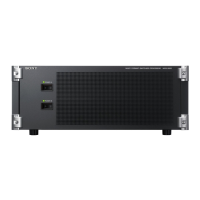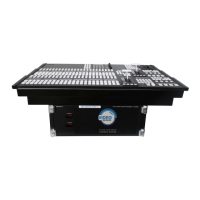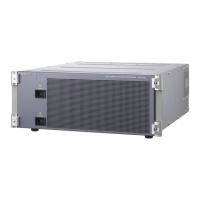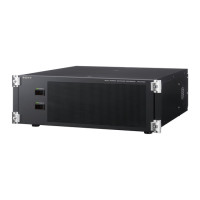518
Operation Settings (Operation Menu)
Chapter 19 Control Panel Setup (Panel)
Operation Settings
(Operation Menu)
To make settings relating to panel operation, use the Panel
>Operation menu.
To display the Operation menu
In the Engineering Setup menu, select VF2 ‘Panel’ and
HF6 ‘Operation.’
The status area shows the items that can be set and a list of
the settings.
The following functions are available here.
• Button Tally: Set whether or not the system tally
generation results are reflected in the panel tally.
• Trans Rate Display: Select whether the transition rate
display mode is in frames or timecode units.
• S-Bus Name Link: Copy the S-Bus description name to
the source name.
• Effect: For keyframe effects, you can make the
following settings.
- Recall mode
- Automatically turning off the [EDIT ENBL] button
when an effect is recalled
- Automatic insertion of a first keyframe when an empty
register is recalled
- Effect Auto Save
- Default KF Duration
- Setting whether or not to replay the first keyframe after
rewinding a GPI/P-Bus/disk recorder/VTR/Extended
VTR/Macro effect
• Source/Dest Name: For the Source/Dest (source/
destination) names used by the system, select one of the
following:
- Source name set by cross-point assignment or fixed
bus name
- Description name set on routing switcher
- “Type + Num” name set on routing switcher
Names assigned with Xpt Assign can be replaced later with
description names.
• Name Display: Specify the number of characters for
display of the names selected in Source/Dest Name
above, as two characters, four characters, or Auto.
• Flexi Pad Mode: Make menu settings for wipe
snapshots.
• Custom Button: Set the following button operation
modes.
- [ALL] button for next transition selection
- [AUTO TRANS] or [TAKE] button during auto
transition execution
- [RUN] button during keyframe execution
- [AUTO TRANS] and [CUT] button replacement
- [TRANS PVW] button
- Key delegation [DME1] to [DME4] button selection
mode
- Key delegation [XPT HOLD] button operation mode
- Selection of signal assigned to the auxiliary bus
control block key source bus (either key signal only, or
either video signal or key signal selectable)
• Sensitivity: Adjust trackball, joystick and double-click
sensitivity, or set the relationship between the angle of
the search dial and the playback speed or the sensitivity
for the search dial in jog mode.
• Macro: Set the macro execution mode.
Setting the On-Air Tally
To set the high tally state reflected on the control panel, use
the following procedure.
1
In the Panel >Operation menu, press [Button Tally].
The Button Tally menu appears.
2
In the <Tally Type> group, select either of the
following.
[R1] to [R8]: Reflect any of tally groups 1 to 8 as the
tally state.
Independent: Reflect only the switcher tally state.
3
Press [Execute].
A popup window appears and shows the progress of
the operation.
Setting the Transition Rate Display
Mode
To determine whether to display transition rate values in
menus and on the control panel in frames or as timecode
values, select either of the following in the <Trans Rate
Display> group.
Frame: display in frames.
Timecode: display as timecode (SS:FF).
Making Settings Relating to Effects
To make settings relating to the functions used when
carrying out keyframe effect operations, use the following
procedure.
1
In the Panel >Operation menu, press [Effect Mode].
The Effect Mode menu appears.
The status area shows a list of the items with their
settings.
2
Make the following settings as required.

